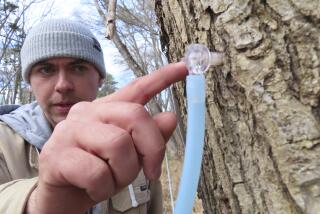Vermont taps into its sugary rites of spring : Trees are awakening from winter hibernation and spilling forth the sap that becomes the state’s most famous product: maple syrup.
- Share via
BRIDGEWATER, Vt. — Spring comes to Vermont not with a sudden blush of blossoms or a burst of cracking ice, but with a slow and silent ritual in the maple groves that speaks of winter’s end.
The ritual takes place every year in this season between the seasons, when the knee-deep forest snow has turned soft underfoot and Vermont--the skiers gone, the tourists not yet arrived--belongs again, if only for a brief interlude, to Vermonters.
Although anyone seen wearing sunglasses here is dismissed as an optimist, the rites of spring began two weeks ago with what is known simply as sugaring time--the time when maple trees awaken from their winter hibernation and spill forth sap that thousands of Vermonters collect and process into the state’s most famous product: maple syrup.
The mom-and-pop industry is worth $12 million a year to Vermont, and the 600,000 or so gallons the state will produce this year represents an important source of income for many residents. Vermont is the world’s largest producer of maple syrup, a product unique to North America.
With the days warming, the nights still cold and the wind blowing in from the west--conditions that stimulate the flow of sap--Everett Towne pushed his way on snowshoes through the woods the other day, checking the spouts he had tapped into his hard-rock maples and the plastic tubing that carries the sap from the spouts to the little wooden sugaring house he had built by the brook behind his home.
The 77-year-old retired woodworker says he remembers when, not long ago, sap trickled into buckets that were carried by hand or horse-sled to the sugaring house. “When I saw my first pipeline,” he recalled, “I said: ‘What the hell is this? Someone’s getting awful lazy.’ But the tubes save you lugging. Gravity’s doing the hard labor now.”
The ritual of sugaring--a season that ends after a few weeks when warm weather cuts off the flow of sap--started with the Native Americans. They used maple syrup as seasoning in almost everything they cooked, from fish to meat, and molded candles from syrup that had been boiled down and crystallized as maple sugar.
They traded or sold their larger blocks of maple sugar, carrying them to market in specially made birch-bark boxes.
In the last year, Vermont has started to market its maple syrup aggressively. Last month, the state sent a delegation to a food show in Japan, where chefs have discovered that maple syrup makes--in addition to its traditional uses as a topping for pancakes and a sweetener for cookies, pies and baked beans--an excellent marinade for fish and a tasty ingredient for soup. The delegation will soon visit Hong Kong.
But Vermont’s real battle is with Americans, who believe that maple syrup is just for pancakes. The lion’s share of the market belongs to imitation products that contain mostly corn syrup, and most Americans who live outside the producing areas don’t have access to pure maple syrup; many don’t know it exists.
In Towne’s sugarhouse, the water-clear sap bubbled on a steel pan placed atop a homemade arch, or wood-burning furnace. Forty gallons of sap must be boiled down to make one gallon of pure syrup, and from the cupola of the sugarhouse and countless others like it scattered through the countryside, clouds of steam pillared into the sky as though winter-weary Vermonters were passing word from hilltop to hilltop that sugaring time was progressing well.
Towne tossed four chunks of wood into the arch. The boiling sap gurgled softly. “The biggest mistake people make the first time they do this is let the sap go down so fast it burns the pan, and I done that once too,” he said. “You have to know just the right time to draw off the syrup.”
He dipped a scoop into the evaporation pan and let the near-syrup drip. It couldn’t be too thin, or thick like molasses. It had to be amber in color, not too dark. It had to have a delicate, clear flavor known as “maple bouquet.” No, Towne decided, the sap wasn’t ready, and he sat in a rocking chair by his arch, a visored cap that said “Chasin’ Rainbows” pushed back on his head.
Outside, the wind had turned the afternoon cold, and dark shadows from the rustling, leafless maples reached across the snow. But here in the sugarhouse there was warmth and brightness and the sound of the roaring fire. And the boiling sap came to Towne like a song of spring.
More to Read
Sign up for Essential California
The most important California stories and recommendations in your inbox every morning.
You may occasionally receive promotional content from the Los Angeles Times.










